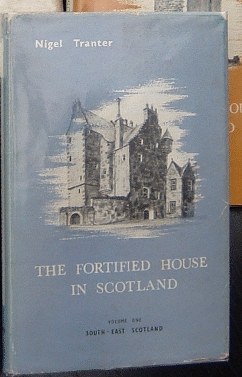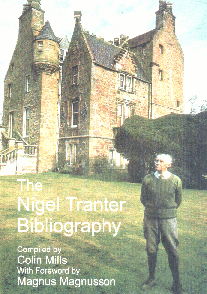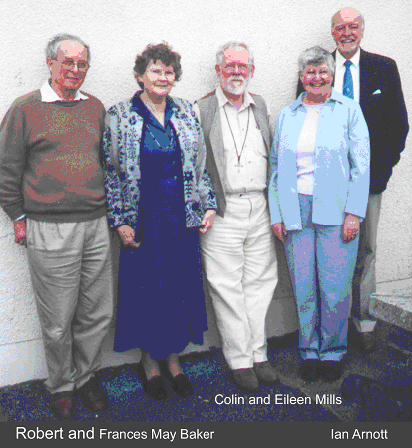

![]()
![]()
![]()
![]()
![]()
As the Chairman of Council of the Saltire Society, I am delighted to have the opportunity of introducing the launch of a Bibliography of Nigel Tranter and its author, Colin Mills. Nigel Tranter was an Honorary President of the Society and, memorably, said, on more than one occasion;
 ďIf more people supported the Saltire Society, Scotland would be a better placeĒ
ďIf more people supported the Saltire Society, Scotland would be a better placeĒ
While this is not the occasion for a lengthy commercial for the Society, his endorsement of our aims and aspirations remain, if anything, truer and more appropriate today than ever.
How, I wonder, would Nigel have viewed the events of the Scottish Parliament election of 1 May? Although not a nationalist in the political sense, I think he would have been disappointed by the poor showing of the SNP. Iím sure he would have been livid that an MSP could be elected with a 20% vote, and saddened that less than half of the Scottish electorate bothered to vote at all.
For todayís events, however, I decided to look at Nigelís work on fortified houses in Scotland, of which he said;
ďMy real lifeís work has always been the study of Scottish fortified houses Ė the novels were only a way of paying the rent.Ē
 His interest was sparked by the growing conservation and improvement lobby in the cities, particularly, Edinburgh. He had a natural talent for observation, and was a self-taught draughtsman of considerable ability. He set to at a young age to record the fortified houses, but his big breakthrough came when he was thirteen, - in the shape of a bicycle. This greatly increased his range, and, although much later he stopped peering over hedges and knocked instead on the front door, the early notebooks were the database for the five volumes of ďThe Fortified House in ScotlandĒ.
His interest was sparked by the growing conservation and improvement lobby in the cities, particularly, Edinburgh. He had a natural talent for observation, and was a self-taught draughtsman of considerable ability. He set to at a young age to record the fortified houses, but his big breakthrough came when he was thirteen, - in the shape of a bicycle. This greatly increased his range, and, although much later he stopped peering over hedges and knocked instead on the front door, the early notebooks were the database for the five volumes of ďThe Fortified House in ScotlandĒ.
Combining his own observation with the scholarship of McGibbon and Rossís ďCastellated and Domestic Architecture of ScotlandĒ, the everlasting source books for anyone studying this field, Tranter set out to record the hundreds of fortified houses Ė or ruins. The recording grew into a desire to restore, and at twenty, he set about becoming an architect.
The Edinburgh practice of Aldjo Jamieson and Arnott (no relation) offered him an apprenticeship but required £400 for indenture. Since his father died in 1929, this sum could not be found. Although disappointed, Nigelís enthusiasm was, if anything, sharpened, and it is arguable that he may have been more influential outside the profession than he would have been in it.
Recently there has been a revival of interest in the history of the Scottish House, a re-examination of the wider context of the times which gave rise to this architecture. Nigel Tranter believed that the Reformation and the edict by James V! requiring estates with a value of £100 or more to erect a fortified house resulted in a great building building programme of castles. But the James V1 edict did not apply with the same force to all of Scotland. It was aimed particularly at the Borders, where conflict was rife and, if other, less warlike, areas chose to erect a castle, the reasons were somewhat different, as were the results.
 The influences on the Scottish Renaissance house seem to have been much wider than 19c historians supposed. The effect of the combination of Mary of Guise and Mary, Queen of Scots, upon the nobility in Scotland brought a degree of sophistication to Scottish life and buildings which, although acknowledged by contemporary English and European observers, was lost on the Victorians, who, sometimes for political reasons, preferred to see Scotland as primitive, warlike, internally quarrelsome and chronically backward Ė needing, in fact, to build basic defensive structures. In fact, recent research reveals that, far from being bare, crude defensive fortresses, the Renaissance house in Scotland was likely to be furnished with silver and gold from Paris, tablecloths from Flanders and tapestries from Holland.
The influences on the Scottish Renaissance house seem to have been much wider than 19c historians supposed. The effect of the combination of Mary of Guise and Mary, Queen of Scots, upon the nobility in Scotland brought a degree of sophistication to Scottish life and buildings which, although acknowledged by contemporary English and European observers, was lost on the Victorians, who, sometimes for political reasons, preferred to see Scotland as primitive, warlike, internally quarrelsome and chronically backward Ė needing, in fact, to build basic defensive structures. In fact, recent research reveals that, far from being bare, crude defensive fortresses, the Renaissance house in Scotland was likely to be furnished with silver and gold from Paris, tablecloths from Flanders and tapestries from Holland.
So it now seems that, over the sixteenth and early seventeenth centuries, a real need for fortified structures gave way to a romantic need; very quickly the turrets, gun loops and machicolations became symbols of status rather than means of defence. Equally the tower house, never the most convenient living arrangement, became closer to a rich manís folly attached to a courtyard of functional buildings. Why else build Scotstarvit or Amisfield without a kitchen, or put in five rooms out of seven with no fireplaces to heat them?
Currently the Scottish fortified house is being re-examined as a deliberate cultural
 product and its role as metaphor is being refocused. There will be more surprises in store; how it was conceived, its proportional systems and their symbolism.
product and its role as metaphor is being refocused. There will be more surprises in store; how it was conceived, its proportional systems and their symbolism.
How does this affect Nigel Tranterís work? Has it become out-of-date, less relevant, not as accurate as he thought? Emphatically not, for his five volumes on the fortified houses remain, as they have for forty-odd years, a unique personal record, irreplaceable as a database and, in Nigelís own development, the foundation that made possible his historical novels Ė novels which, in turn, brought Scottish history alive for so many of his fellow countrymen.
And it is Tranterís oeuvres completes which reveal the extent of his imagination and creativity. So the launch of Colin Millsí comprehensive bibliography is an important occasion for it is not simply a reference for future scholars, it is a record of the manís life and work which may surprise even those of his many friends and readers who thought they knew him.
Thank you Ian for speaking about Nigelís interest in the castles and their architecture, and thank you for introducing me.
 I remember, and I suppose it was about 8 years ago, sitting in the Library of Brodick Castle chairing a committee meeting of The Friends of Brodick Castle and Country Park, which with the then Administrator I had co-founded a couple of years previously. How Nigel Tranter became the topic of conversation I canít remember, possibly the fact that some of us envied the famous historical books that line the walls.
I remember, and I suppose it was about 8 years ago, sitting in the Library of Brodick Castle chairing a committee meeting of The Friends of Brodick Castle and Country Park, which with the then Administrator I had co-founded a couple of years previously. How Nigel Tranter became the topic of conversation I canít remember, possibly the fact that some of us envied the famous historical books that line the walls.
Or, it might have been due to the fact that talk to me long enough and Nigel Tranter will crop up in the conversation. I would imagine that most of my friends, and I am surprised I still have any, if they did not know of Nigel before they do now! For Nigel Tranter has become very much a part of my life and it is a disappointment that I never had the privilege of meeting him, and so I am very pleased that Frances May, Nigelís daughter, is here today.
Returning to that meeting in Brodick Castle, I remember that some of my committee were scornful of Nigel Ė that his historic novels were not history at all but the subject of a vivid imagination. Yes, he did have a vivid imagination, but what ignorance was shown about his integrity to portray real historic events and people in such a lively manner.
 It was in the early 1970s that I began reading historic novels written by Nigel Tranter when holidaying on Arran. They were the trilogy of books about Robert the Bruce. A topical subject on Arran, where we have the cave in which he supposedly watched the famous spider. Later I read the two books about the Great Montrose, whose descendant was to become the Laird of Arran.
It was in the early 1970s that I began reading historic novels written by Nigel Tranter when holidaying on Arran. They were the trilogy of books about Robert the Bruce. A topical subject on Arran, where we have the cave in which he supposedly watched the famous spider. Later I read the two books about the Great Montrose, whose descendant was to become the Laird of Arran.
I had never read historical novels before but I was soon enchanted by the way Nigel brought history to life. Later I read his earlier novels that I believe are sadly overlooked by so many of his admirers. And then there are his travelogues of Scotland and the books about the fortified houses and lesser castles of Scotland that Ian has spoken to us about. Definitive works that Magnus Magnusson in his Foreword to my book believes will be Nigelís greatest memorial and for which he will be most remembered.
Today is the culmination of some four years work preparing and compiling the bibliography of Nigelís vast opus. Thank you for coming today and I hope you will find my book a useful adjunct to your Nigel Tranter collection. In it you will find my acknowledgements to all who have encouraged and helped me; to them a big THANK YOU.
(This was followed by the presentation of copies of the bibliography to Frances May and Ian Arnott).
![]()